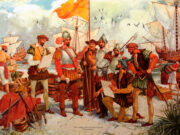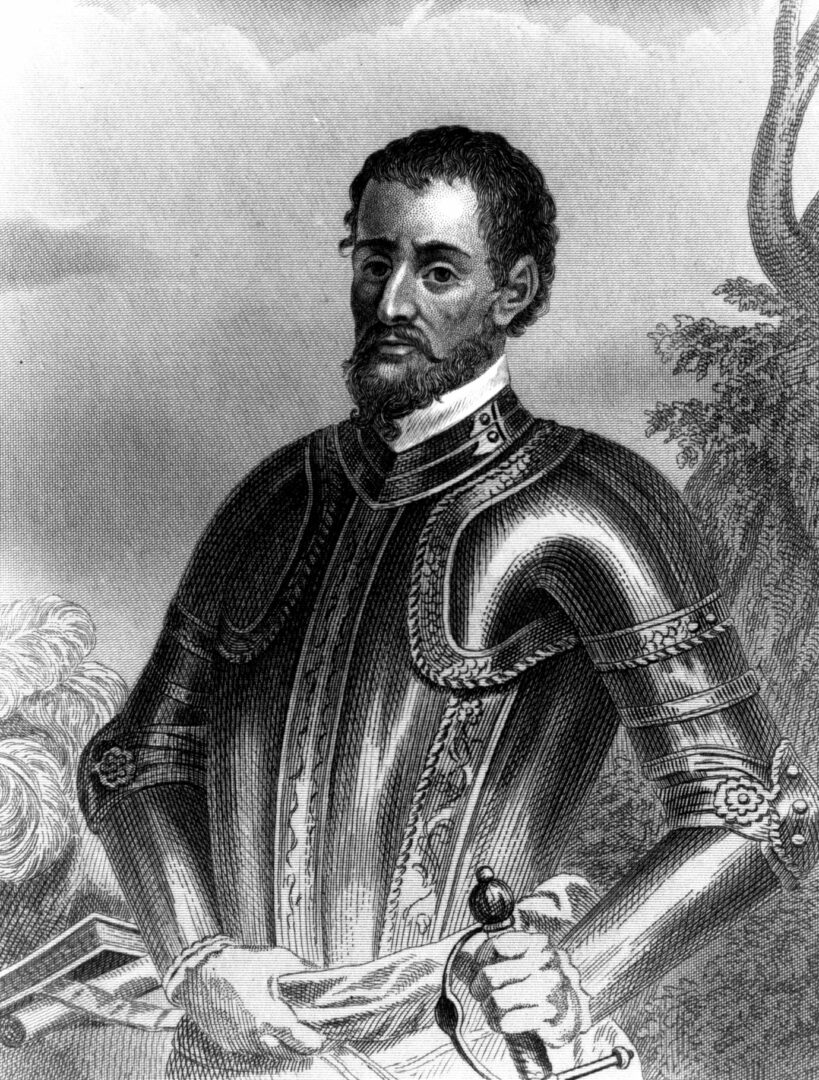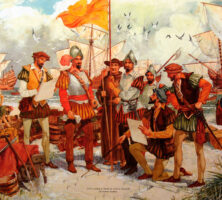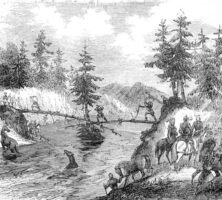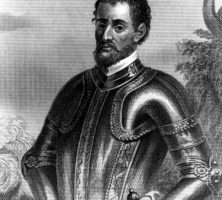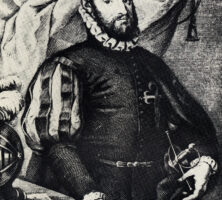The initial European exploration of Georgia was carried out in large part by Spaniards, first operating out of colonial bases in the Caribbean Sea and Mexico and later from the city of St. Augustine on the Florida coast. Between 1525 and 1646, expeditions large and small explored both the coast and the interior of Georgia, covering most of the inhabited portions of the Coastal Plain and parts of the lower Piedmont.
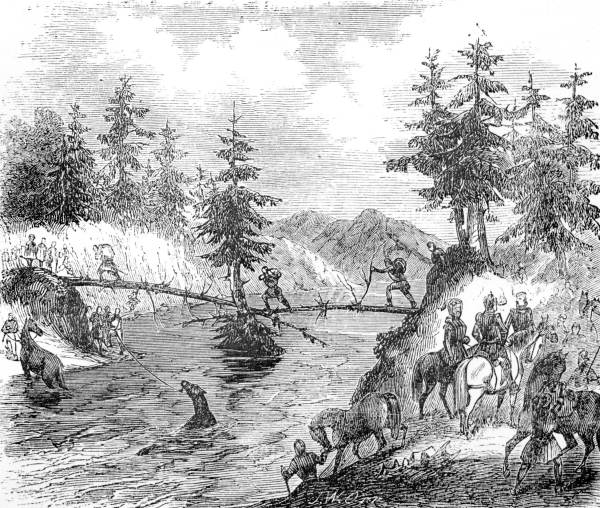
Courtesy of Florida State Archives
Allyon Expedition
The first documented exploration was carried out along the coastline in 1525 by two ships from Puerto Rico under pilot Pedro de Quejos, who had landed in South Carolina in 1521 on a slaving expedition. This brief reconnaissance of the entire coastline prefaced the subsequent colonial venture of Lucas Vazquez de Ayllon, whose 600 colonists first made landfall in South Carolina before moving south, following Indian trails, to the Georgia coast in 1526. There, in an as yet undiscovered location (perhaps near Sapelo Sound), Ayllon established the short-lived colony of San Miguel de Gualdape, which was abandoned just six weeks later, following political disputes and an uprising by enslaved Africans.
De Soto Expedition
In the spring of 1540, an army of some 600 Spanish soldiers under the command of Hernando de Soto marched north from Florida into southwestern Georgia in search of riches. The expedition crossed the Flint River near present-day Newton, visited the chiefdom of Capachequi located along Chickasawhatchee Creek, and then pushed northeast toward present-day Marshallville, where they recrossed the Flint and stopped briefly at a village called Toa. The soldiers then moved east to the Ocmulgee chiefdom of Ichisi, with its capital at the Lamar Mound site (from which the Lamar Period of Georgia prehistory gets its name) near present-day Macon and then to the Oconee River villages of Altamaha, Ocute, and Cofaqui. The expedition continued east into South Carolina, turned north to cross the Appalachian summit in western North Carolina and eastern Tennessee, and finally dropped south again into northwestern Georgia during July. The army stayed more than a month in the capital of the powerful Coosa chiefdom near present-day Calhoun and then marched south to Itaba (Etowah) near Cartersville before following the Etowah River west to Ulibahali at Rome, and subsequently downriver along the Coosa River to Apica and finally into Alabama.
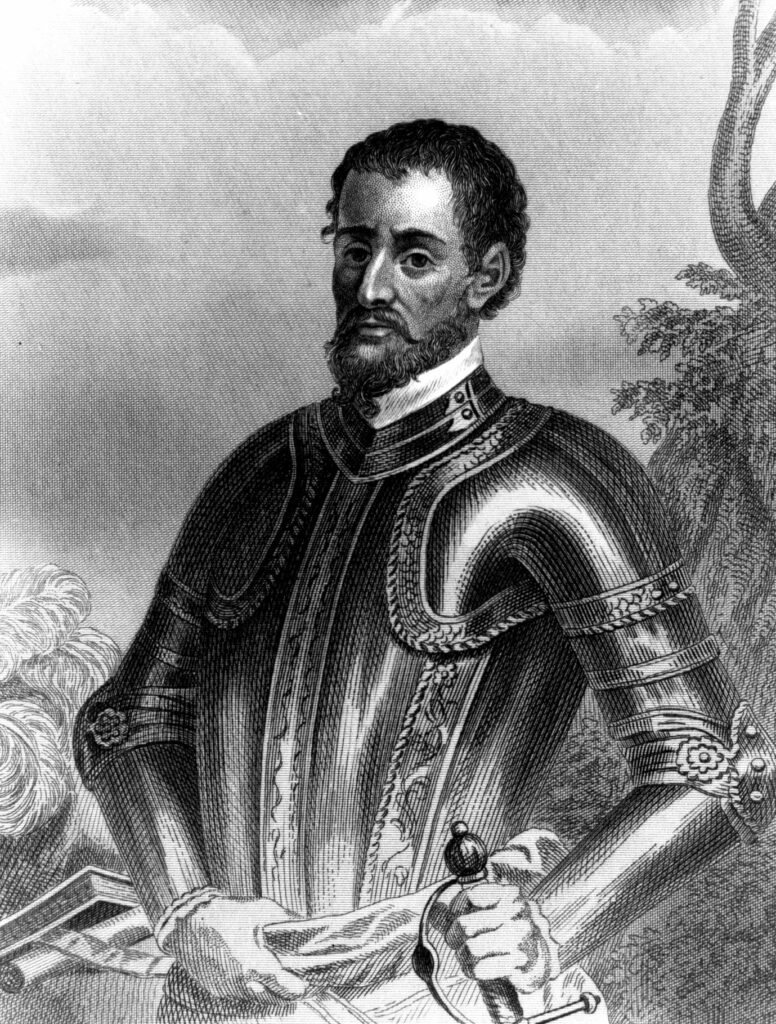
Courtesy of Georgia Info, Digital Library of Georgia.
The impact of the 1539-43 Hernando de Soto expedition was enormous. Not only did surviving Spanish chroniclers offer their first and last glimpse of pristine Native American chiefdoms across the interior southeastern United States, but the accidental introduction of European plague diseases most likely resulted in massive epidemic population losses in these same regions.
De Luna Colony
In the aftermath of the de Soto expedition the Spanish crown first mounted an abortive missionary effort by Dominican priests under Fray Luis Cancer on the Gulf Coast of the Florida peninsula in 1549. In 1559 they launched a massive colonial venture under Tristan de Luna, when some 1,500 Mexican soldiers and colonists sailed from Vera Cruz to Pensacola Bay, where a hurricane destroyed most of their ships and supplies shortly after arriving. The colonists moved inland in search of food at a town called Nanipacana, but when their supplies were exhausted, in April 1560, Luna sent a detachment of 140 soldiers and 2 Dominican friars northward, backtracking along de Soto’s earlier route toward the populous chiefdom of Coosa in northwest Georgia. Several of the officers were veterans of the de Soto expedition who had settled in Mexico. The detachment passed through Apica and Ulibahali before arriving at Coosa, where they spent several months. During this stay a detachment of these men accompanied the Coosa chief and warriors on a military raid against the rebellious province of Napochin near present-day Chattanooga, Tennessee.
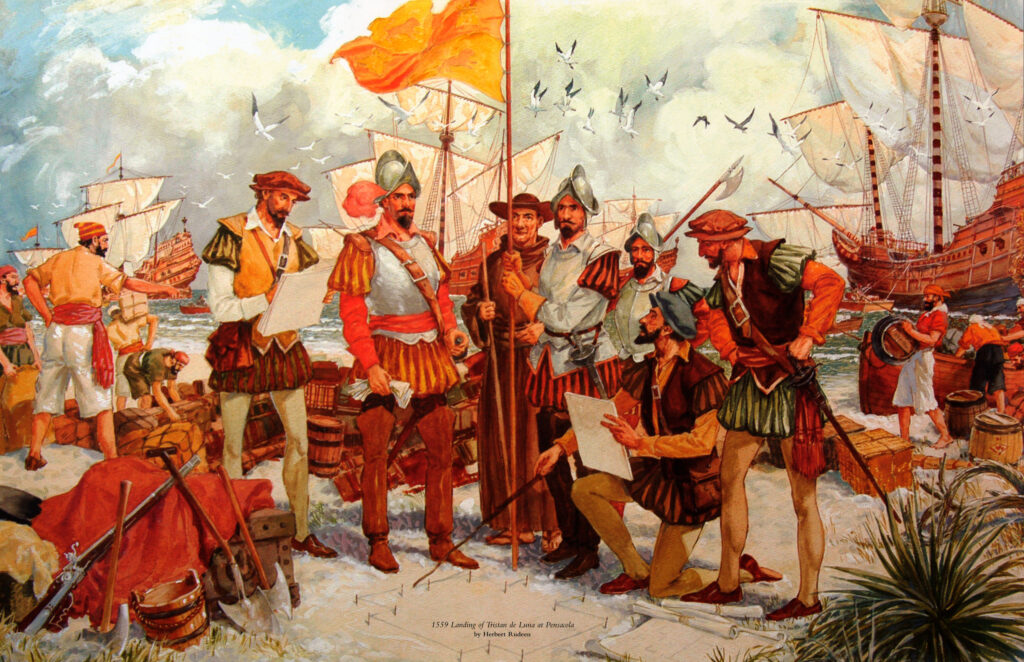
Courtesy of Pensacola Historical Society
Later Expeditions
In 1561, after the Luna colony failed and the colonists returned to Mexico, Luna’s replacement, Angel de Villafane, led a ship around the Florida peninsula briefly to reconnoiter the Atlantic coastline of Georgia and South Carolina. This same region soon witnessed a flurry of activity by other European explorers. In 1562 French sailors under Jean Ribault reconnoitered the coastline before establishing Charles Fort on Parris Island, South Carolina, and two years later a Cuban ship under Hernando Manrique de Rojas scoured the coast in search of the abandoned French fort, which they destroyed. That same year French ships visited the Georgia coast from Rene de Laudonniere’s new colony at Fort Caroline near present-day Jacksonville, Florida, but it was Spanish colonists under Pedro Menendez de Aviles that completed this coastal exploration in the decades after the 1565 founding of St. Augustine, Florida.
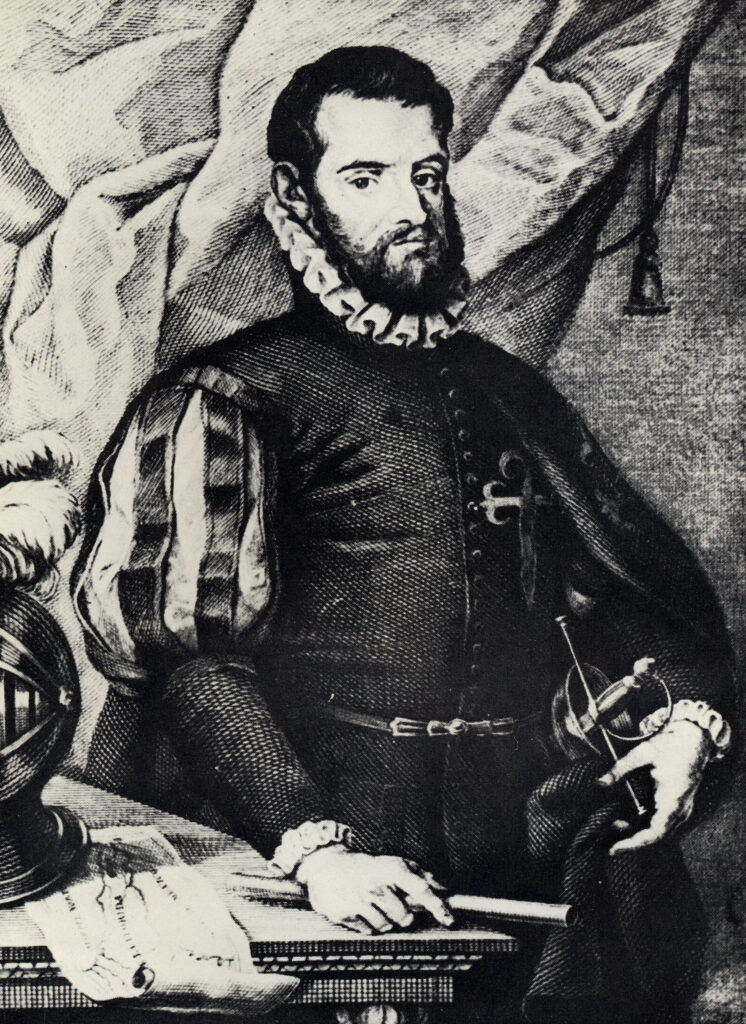
From The Spanish Settlements within the Present Limits of the United States: Florida, 1562-1574, by W. Lowery
Although two major military expeditions under Captain Juan Pardo were dispatched into the Appalachian mountains between 1566 and 1568 from the short-lived Spanish colonial city of Santa Elena on Parris Island, Georgia’s interior saw no further exploration until 1597, when two Franciscan missionaries and a soldier briefly pushed inland as far as Altamaha and Ocute near present-day Milledgeville. When Spaniards heard rumors of an overland expedition from Mexico, they sent yet another expedition to these same towns under soldier Juan de Lara in 1602, and at least five reconnaissance expeditions were dispatched into the interior Coastal Plain between 1624 and 1628, including two trips under Ensign Pedro de Torres that penetrated as far as central South Carolina.
During this same period Franciscan missionaries explored other populated regions of southern Georgia, establishing missions at Utinahica near present-day Lumber City, Ibihica and Ocone near Folkston, and Cachipile and Arapaja near Valdosta by 1630. The well-documented expedition by Fray Luis Geronimo de Ore in late 1616 skirted the back side of the Okefenokee Swamp before descending the Altamaha River to the coast.
The final Spanish exploratory expedition into Georgia’s interior took place in the winter of 1645-46, when Florida governor Benito Ruiz de Salazar Vallecilla led a group of soldiers north from the Apalachee mission province into the villages of the unconverted Apalachicola province along the lower Chattahoochee River in southwest Georgia and eastern Alabama. Though there were sporadic visits to these villages as late as 1695, the Ruiz expedition was the last major Spanish exploratory venture into Georgia. The remaining portions of north Georgia would eventually be explored by English traders and soldiers during the late seventeenth and early eighteenth century, long before ownership of the land was acquired through treaties between 1733 and 1838.


